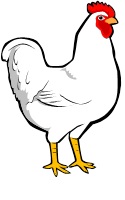 Avian Influenza Update - August 19, 2015 Jeff Schalau, Agent, Agriculture & Natural Resources University of Arizona Cooperative Extension, Yavapai County Arizonans have been hearing about Avian Influenza (AI) in multiple states and some bird owners and avian enthusiasts may feel somewhat removed from the current outbreaks. Small, backyard chicken flocks are also very popular and these poultry owners may not be aware their birds are at risk for contracting AI. Wild birds such as migratory ducks and geese have historically been known as reservoirs for AI viruses. These birds can carry low pathogenicity (i.e. less lethal) avian influenza viruses in their respiratory or intestinal tracts and usually do not get sick. However, AI viruses, particularly H5 and H7 strains, can infect domestic poultry such as chickens and turkeys resulting in severe economic losses due to reduced production and increased mortality. Infected birds shed avian influenza virus in their saliva, nasal secretions, and feces. Domestic poultry become infected with the virus through direct contact with infected waterfowl or other infected poultry, or through contact with contaminated surfaces and material. As the virus circulates within the domestic and possibly resident wild bird populations, it can mutate into new forms of the virus. Low pathogenic forms of the virus can mutate into highly pathogenic AI. The newly formed virus is lethal to poultry and possibly to the wild birds from which it arose. In rare cases, a highly pathogenic strain which kills poultry has infected and killed some humans in many countries, but not in the United States. The human type is often referred to as “bird flu”. In December 2014, the USDA identified highly pathogenic avian influenza virus strains in the Pacific Flyway (a set of pathways in western states where birds migrate seasonally). Recent AI outbreaks started in the Pacific Northwest and have now spread to commercial chicken and turkey farms in the Midwest. As of May 12, 2015, 158 outbreaks have resulted in the death or culling of more 33 million birds in 15 states. USDA recommends that owners of backyard flocks follow these instructions to help prevent avian influenza and other poultry diseases. Restrict access from wild waterfowl and other birds to your flock by use of an enclosed shelter and fencing of the outdoor areas. Caretakers should not have contact with other poultry or birds prior to contact with their own birds. Restrict access to your poultry if your visitors have birds of their own. Keep different species of poultry and age groups separated due to differences in susceptibility. Look at your own setting, what can you do to prevent your birds from contact with other birds that could introduce AI? Keep poultry areas clean. Don't haul disease home. If you have been near other birds or bird owners, clean and disinfect your poultry cages and equipment before going home. Don't share diseases with your neighbors – this includes egg cartons. Do not borrow lawn and garden equipment, tools, or poultry supplies from other bird owners. It is also important to know the symptoms of highly pathogenic avian influenza. These include: sudden increase in bird deaths; sneezing, coughing, nasal discharge; watery or green diarrhea; lack of energy; drop in egg production; swelling around the eyes, neck, and head; and purple discoloration of wattles, combs, and legs. There were some suspected cases of AI in Arizona in June 2015. The sites were in Pinal, Mohave, Santa Cruz and Yavapai Counties and originated with a shipment of thirteen young quail and chickens and about 40 quail and partridge eggs imported from a facility in Iowa. Birds at the Iowa facility became sick and the initial test results for those birds came back positive for H5 AI. Thankfully, none of the Arizona cases tested positive. No quarantines are currently in place, however all poultry owners should be vigilant. If your flock experiences a sudden, high mortality (two or more birds in a short time period) or has a high percentage of birds with the signs described above, please report this immediately to your veterinarian or to the State Veterinarian with the Arizona Department of Agriculture (ADA) at (602) 542-4293. Also, I’d like to thank the ADA State Veterinarian’s Office for reviewing this material prior to publication. I have included additional AI resources below. Follow the Backyard Gardener on Twitter – use the link on the BYG website. If you have other gardening questions, call the Master Gardener help line in the Camp Verde office at 928-554-8992 or e-mail us at verdevalleymg@gmail.com and be sure to include your name, address and phone number. Find past Backyard Gardener columns or provide feedback at the Backyard Gardener web site: http://cals.arizona.edu/yavapai/anr/hort/byg/. Additional Resources Avian Influenza Arizona Department of Agriculture agriculture.az.gov/animal-services/avian-influenza Avian Influenza Homepage eXtension.org (a national collaboration between state Cooperative Extension systems) www.extension.org/pages/24425/avian-influenza-homepage#.VczIOfmvMqg Avian Influenza Basics for Urban and Backyard Poultry Owners University of Minnesota Extension (remember to report suspected Arizona avian influenza outbreaks to the Arizona Department of Agriculture as described in the text above) www.extension.umn.edu/agriculture/poultry/avian-influenza/avian-influenza-backyard-poultry/index.html |